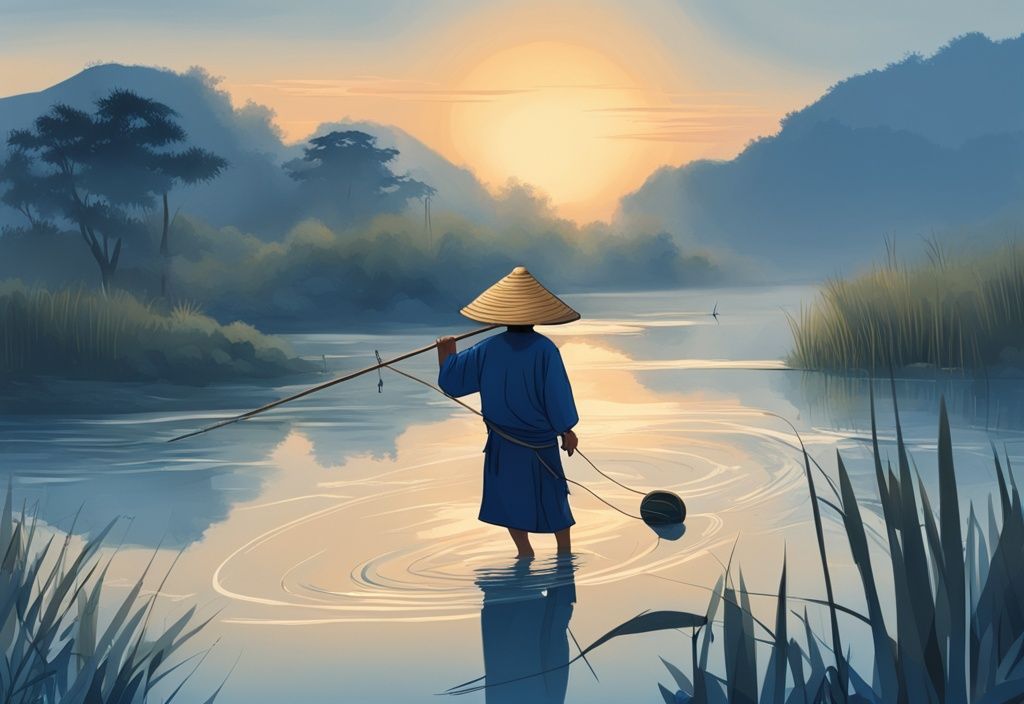You ever heard of Asian Fishing? No, it’s not about casting nets in the Pacific! It’s a puzzling trend where non-Asian folks tweak their look to mirror East-Asian traits. It’s more than just a new-fangled fad from the world of social media.
In this article, we’re cracking open this can of worms. We’ll delve into the nitty-gritty of Asian Fishing. What sparked it off? What’s fueling this trend? And most importantly, why is it causing such a hullabaloo?
Hang onto your hats, folks. We’re not just discussing the hot topic of Asian Fishing. We’re scrutinizing its societal implications, diving deep into the ripple effects it has on folks belonging to Asian communities and exploring ways to encourage genuine cultural connection.
What is Asian Fishing?
So, you’re probably wondering, just what is Asian fishing? Well, it’s essentially when non-Asian individuals adopt East-Asian appearances through various tweaks and tricks. Imagine using makeup to alter your facial features, or photo-editing software to enhance these changes. Some folks even go as far as donning stereotypically Asian costumes, like anime girl outfits or video game character costumes.
This trend stirs up quite a bit of controversy, and for good reason. For starters, it reinforces some pretty harmful beauty standards. By altering how they look to mimic East-Asian traits, people are buying into a homogenized and unrealistic beauty ideal. This impacts both Asian and non-Asian communities, fostering unhealthy views of beauty.
Plus, it isn’t just about the looks. This cultural mimicry often feeds into existing racial stereotypes, giving a narrow and inaccurate portrayal of what it means to look East-Asian. It’s like painting over a rich, diverse culture with a single broad, misleading brushstroke.
Diving deeper, Asian fishing often tips the scale into full-blown cultural appropriation. Instead of appreciating the rich complexities of Asian cultures, those who partake in this trend do it mainly for aesthetics or social media clicks. This trivializes and disrespects the genuine lived experiences and deep cultural histories of Asian communities.
Reducing cultural symbols and appearances to mere fashion statements isn’t just dismissive—it’s hurtful. Asian fishing’s impact goes beyond the visual; it disrespects and oversimplifies a whole lineage of traditions and identities.
When you sum it up, Asian fishing is far from a harmless trend. It strikes at the core of racial dignity and cultural sensitivity. By turning physical traits and cultural symbols into fashion commodities, participants end up reinforcing stereotypes, disrespecting cultures, and pushing unrealistic beauty standards.
Origins and Definition of Asian Fishing
In this section, we’ll dive into the concept of Asian Fishing, explore notable examples, and touch on the historical context behind this controversy.
Understanding the Concept and Notable Examples
So, what is Asian Fishing? It’s when non-Asian folks transform their looks to mimic East-Asian facial features—think of it as a modern twist on cultural appropriation. They often use makeup tricks to elongate their eyes or create a slanted-eye effect, and photo-editing software to amp up these changes, making their faces look unmistakably East-Asian.

One prominent example is Oli London, an influencer who’s taken things up a notch. Extensive surgeries to look like an Asian K-pop star? Oli’s done it. And why? Social media trends. Platforms are buzzing with anime-inspired makeup and ‘kawaii’ aesthetics, giving this trend a massive boost.
Historical Background of Asian Fishing
Here’s something worth pondering: historically, Asian women have faced racism, violence, and hypersexualization. Asian Fishing doesn’t just draw from these troubling issues—it amplifies them. It perpetuates the fetishization and cultural disrespect that have long been a thorn for Asian communities.
The parallels with blackfishing are hard to miss. Just like individuals who mimic African-American features to score social media points, Asian Fishing is another layer of racial appropriation. Both practices root in a deeper history of cultural exploitation and misrepresentation. Features and styles that should be unique and respected are, instead, taken out of context and turned into commodities by non-ethnic individuals for a little extra clout.
The Techniques of Asian Fishing
Honestly, it’s a bit surprising how makeup and styling techniques have found their way into what’s called Asian Fishing. This phenomenon involves folks using makeup and dress-up to emulate East-Asian features, often in a way that raises eyebrows and questions about cultural sensitivity.
Makeup and Styling Techniques in Asian Fishing
Asian Fishing, at its core, uses makeup to create an illusion of East-Asian features. You might have seen those ‘fox-eye’ trends where eyeliner and lashes work overtime to stretch and slant the eyes. Imagine applying liner so deliberately that it changes the natural contours of your face. That’s the game here, and it has gained quite a following.
Now, it doesn’t stop at the eyes. Inspired by the allure of K-pop idols and anime icons, individuals dive into a palette of porcelain skin, flushed cheeks, and those distinct lip tints. The aim is to nail that East-Asian aesthetic, driven by the waves created by popular culture. A swipe of blush here, a dab of tint there, and voila—a new look is born.
But there’s more. People donning Japanese school uniforms or other stereotypical outfits seen in Asian media are all in the mix too. Think of it like a dress-up game, but one that’s treading a very fine line. It’s about imitating those iconic looks, attire often popularized and somewhat fetishized by anime. This isn’t just about a costume—it’s a touchy subject that brings up issues of exoticization and cultural reduction.
The Role of Photo-editing in Asian Fishing
Photo-editing is yet another powerful technique used in Asian Fishing. With today’s advanced editing tools, people can tweak their photos to add East-Asian features. We’re talking about digital magic that can make the corners of the eyes tilt upwards for that almond-shaped effect.
It’s not just makeup anymore; editing software allows for a complete and lasting transformation of images. Filters play a role, too, lightening skin tones to achieve that porcelain sheen idolized in some Asian cultures. These edited photos then tap into the social media vein, circulating and gaining traction. Filters, apps, you name it—they all contribute to this digital facade that’s normalized through repeated viral posts.
This isn’t just a casual editing gig. These images mold public perceptions of beauty, setting standards that can be problematic. When authenticity is sacrificed for an edited image, the cultural significance of East-Asian features takes a hit. Besides, these online portrayals perpetuate a cycle. People look, they like, and they mimic, hoping for the same validation and likes. It’s a never-ending loop that prizes looks over substance, and that’s where things get murky, raising questions about cultural appreciation versus appropriation.
The Controversy of Asian Fishing
Asian Fishing isn’t about casting a line into tranquil waters, but instead, it refers to a controversial practice that’s been making waves online. This issue encompasses various subtopics, each shedding light on different facets of the controversy and its broader implications.
Asian Fishing and Cultural Appropriation
Asian Fishing, where non-Asian individuals adopt East-Asian features through makeup, photo-editing, and costumes, has sparked considerable debate. This practice is criticized as cultural appropriation rather than cultural appreciation. Often driven by a hunger for social media fame and aesthetic allure, it reveals a shallow engagement with East-Asian cultures, lacking genuine respect or understanding.
Many of those involved in Asian Fishing are non-Asian, primarily white individuals. This adds another layer of complexity, intertwining issues of privilege and superficiality.
Now, cultural appropriation generally means adopting elements from a minority culture without acknowledging their true context and significance. In the case of Asian Fishing, the identities of Asian communities are trivialized and commercialized. What is Asian fishing, then? It’s a blend of misrepresentation and aesthetic exploitation that reduces rich cultural histories to mere trends. By fostering exoticism and fetishizing East-Asian traits, it presents a misplaced and harmful image.

The Perpetuation of Stereotypes through Asian Fishing
Asian Fishing doesn’t just stop at appropriation—it also significantly reinforces damaging stereotypes about Asians. This practice paints Asians as submissive, ever-youthful, and controllable. These aren’t harmless caricatures; they contribute to real-world racial bias and discrimination, affecting everyday lives.
The inherent sexualization and objectification within Asian Fishing underscore deeper issues of misogyny and racial insensitivity. By adopting these exaggerated ethnic features, those engaging in what is Asian fishing spread a skewed, injuring perception of Asian identity. This not only warps public perception but also imposes psychological distress on Asian communities.
Moreover, Asian Fishing enacts a form of symbolic violence. It trivializes the lived experiences of Asian individuals by appropriating cultural symbols and aesthetics for fleeting social media trends. The profound histories and meanings attached to these elements are ignored. This leads to an environment where cultural insensitivity thrives and genuine understanding is largely absent.
In the end, this issue implores us to reflect: What is Asian fishing truly costing our society?
The Impact and Consequences of Asian Fishing
Asian Fishing is a thorny issue that’s got more layers than a well-tied fly. Let’s dive deep into its murky waters and explore how this practice affects beauty standards and the genuine lived experiences of Asian communities.
How Asian Fishing Contributes to Distorted Beauty Standards
Asian Fishing, where non-Asian individuals change up their looks to emulate East-Asian features, is like casting a line into troubled waters. It muddles the beauty standards, much like a snagged fishing line messes up a perfect cast. You see, this practice doesn’t just toy with personal image—it echoes those outdated, patriarchal beauty ideals and fetishizes traits that, for too long, have been the butt of jokes. By promoting these altered aesthetics, folks indulging in Asian Fishing are tossing back genuine diversity in favor of a narrowly defined, often unattainable, standard of beauty, which can have significant economic repercussions, costing the U.S. economy billions each year due to body dissatisfaction and appearance-based discrimination, as highlighted by a recent report from the Harvard T.H. Chan School of Public Health. Read more here. It’s like embracing just one type of fish and ignoring the rich variety that waters have to offer. To truly explore this diversity, consider using the best underwater fishing cameras for a more immersive experience. This not only undervalues natural beauty but also erodes the appreciation for cultural authenticity, reinforcing damaging societal norms.
The Unseen Consequences for Asian Communities
Though those diving into Asian Fishing might hook a bit of social media fame, it’s the Asian communities who are left fish out of water. These communities deal with a whole lot more than just a few harsh comments—think actual harassment and violence. It’s apples and oranges compared to the free pass often enjoyed by those imitating their features.
By trivializing the struggles that come with being Asian, this practice disrespects and marginalizes real, lived experiences. It’s like fishing in a lake and ignoring the ecosystem that sustains it. Moreover, Asian Fishing keeps the cycle of racial insensitivity churning, contributing to broader issues of cultural disrespect and inequality. It’s not just a misguided hobby; it’s a harmful ripple in a much larger pond.
Figures and Trends in Asian Fishing
Public Figures and Their Role in Promoting Asian Fishing
Public figures, especially influencers, have a knack for thrusting the trend of what is Asian fishing into the limelight. They ride the waves of social media fame and financial gain, using platforms like Instagram, TikTok, and YouTube to flaunt their modified looks mimicking East-Asian features. Take Oli London, for instance. This individual has gone through a slew of surgeries to resemble an Asian K-pop star. By doing so, these influencers amass huge followings and end up bolstering the trend with their substantial online clout.
But here’s the kicker—they’re also spreading damaging cultural stereotypes and nudging others down this problematic path. It’s a concerning cycle that needs attention and understanding.
Asian Fishing in Media and Trendsetting
Media trends have a powerful hand in shaping what is Asian fishing, amplified further by the social media buzz. Remember the ‘fox-eye’ trend? It subtly adjusts the eyes to appear more slanted, catching wildfire popularity. And don’t get me started on the Japanese school uniform look—mainstream media and cosplay communities have taken to it, often exoticizing cultural attire. Instagram, in particular, has become the stage where these trends shine the brightest. Users share photos and videos, edited to enhance East-Asian features, and these posts gain traction, normalizing the behavior.
It’s a media-fueled cycle that keeps the trend alive, making it crucial to address its harmful repercussions.

Resolving the Issue of Asian Fishing
The practice of Asian fishing is a complex issue that spans several cultural and social concerns. Here’s how we can start moving the needle on awareness and appreciation.
Steps Towards Raising Awareness About Asian Fishing
Grasping what is Asian fishing is your ticket to understanding its far-reaching impact. It’s eye-opening once you dive into how it perpetuates damaging stereotypes. You’ve got to teach folks why this practice is harmful. Think education campaigns, lively debates, and making some noise about how Asian fishing fuels negative beauty standards.
Being culturally sensitive isn’t just fluff. It’s about people realizing that what they do has real-world consequences. Take a moment to listen to personal stories and documented cases. Feel the weight of it. It’s a powerful way to grow awareness and build genuine sensitivity.
Team up with Asian organizations and influencers. They’re the real deal, folks who live and breathe this culture. Their stories aren’t just tales; they’re truths that can shift perspectives among non-Asians. When this authentic voice is heard, we can reduce Asian fishing and its ripples.
Appreciating Asian Culture Without Appropriation
True appreciation is more than skin deep. It’s sitting down, listening, and learning from Asian communities. Dive into their arts, traditions, and customs genuinely—no shortcuts. By doing so, you can avoid stereotypical portrayals and really get the rich, vibrant diversity of Asian cultures.
Part of understanding what is Asian fishing means resisting that itch to change your look to match an East-Asian stereotype. There’s so much more you can do to appreciate the culture. Why not delve into their art or traditions in a way that shows respect? It makes a world of difference.
Lending support to Asian voices in media and culture packs a punch against appropriation. When you promote Asian artists, writers, and influencers, you’re doing more than boosting representation. You’re helping ensure their cultural narrative stays real and varied.
FAQ
What makes Asian Fishing offensive?
Asian Fishing is offensive because it fetishizes and sexualizes Asian appearances. This harmful practice reduces a rich culture to mere aesthetics, enforcing damaging stereotypes and stripping away the authenticity of lived experiences by treating them as a costume or trend.
How to recognize Asian Fishing?
Detecting Asian Fishing often starts with noticing alterations in makeup aimed at mimicking East-Asian features. This can include elongating the eyes or creating slanted-eye effects. Additionally, it often involves heavily edited photos to enhance these appearances, alongside the adoption of stereotypical Asian costumes and aesthetics.
What can be done to Stop Asian Fishing?
Stopping Asian Fishing requires raising awareness about its detrimental impacts. Advocate for genuine cultural appreciation over appropriation, support initiatives that foster racial sensitivity, and participate in educational programs that promote respect for all cultures.


